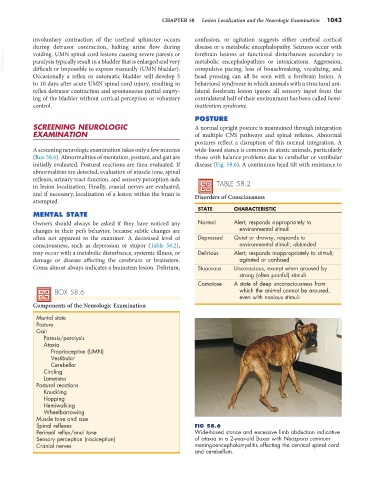Page 1071 - Small Animal Internal Medicine, 6th Edition
P. 1071
CHAPTER 58 Lesion Localization and the Neurologic Examination 1043
involuntary contraction of the urethral sphincter occurs confusion, or agitation suggests either cerebral cortical
during detrusor contraction, halting urine flow during disease or a metabolic encephalopathy. Seizures occur with
VetBooks.ir voiding. UMN spinal cord lesions causing severe paresis or metabolic encephalopathies or intoxications. Aggression,
forebrain lesions or functional disturbances secondary to
paralysis typically result in a bladder that is enlarged and very
compulsive pacing, loss of housebreaking, vocalizing, and
difficult or impossible to express manually (UMN bladder).
Occasionally a reflex or automatic bladder will develop 5 head pressing can all be seen with a forebrain lesion. A
to 10 days after acute UMN spinal cord injury, resulting in behavioral syndrome in which animals with a structural uni-
reflex detrusor contraction and spontaneous partial empty- lateral forebrain lesion ignore all sensory input from the
ing of the bladder without cortical perception or voluntary contralateral half of their environment has been called hemi-
control. inattention syndrome.
POSTURE
SCREENING NEUROLOGIC A normal upright posture is maintained through integration
EXAMINATION of multiple CNS pathways and spinal reflexes. Abnormal
postures reflect a disruption of this normal integration. A
A screening neurologic examination takes only a few minutes wide-based stance is common in ataxic animals, particularly
(Box 58.6). Abnormalities of mentation, posture, and gait are those with balance problems due to cerebellar or vestibular
initially evaluated. Postural reactions are then evaluated. If disease (Fig. 58.6). A continuous head tilt with resistance to
abnormalities are detected, evaluation of muscle tone, spinal
reflexes, urinary tract function, and sensory perception aids
in lesion localization. Finally, cranial nerves are evaluated, TABLE 58.2
and if necessary, localization of a lesion within the brain is Disorders of Consciousness
attempted.
STATE CHARACTERISTIC
MENTAL STATE
Owners should always be asked if they have noticed any Normal Alert; responds appropriately to
changes in their pet’s behavior, because subtle changes are environmental stimuli
often not apparent to the examiner. A decreased level of Depressed Quiet or drowsy, responds to
consciousness, such as depression or stupor (Table 58.2), environmental stimuli; obtunded
may occur with a metabolic disturbance, systemic illness, or Delirious Alert; responds inappropriately to stimuli;
damage or disease affecting the cerebrum or brainstem. agitated or confused
Coma almost always indicates a brainstem lesion. Delirium, Stuporous Unconscious, except when aroused by
strong (often painful) stimuli
Comatose A state of deep unconsciousness from
BOX 58.6 which the animal cannot be aroused,
even with noxious stimuli
Components of the Neurologic Examination
Mental state
Posture
Gait
Paresis/paralysis
Ataxia
Proprioceptive (UMN)
Vestibular
Cerebellar
Circling
Lameness
Postural reactions
Knuckling
Hopping
Hemiwalking
Wheelbarrowing
Muscle tone and size
Spinal reflexes FIG 58.6
Perineal reflex/anal tone Wide-based stance and excessive limb abduction indicative
Sensory perception (nociception) of ataxia in a 2-year-old Boxer with Neospora caninum
Cranial nerves meningoencephalomyelitis affecting the cervical spinal cord
and cerebellum.

